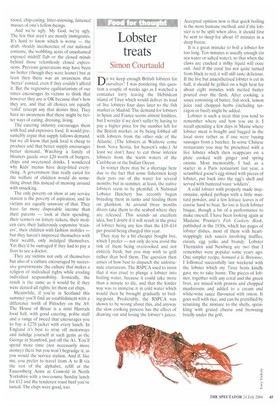Lobster treats
Simon Courtauld
Do we keep enough British lobsters for ourselves? I was pondering this question a couple of weeks ago as I watched a container lorry leaving the Hebridean island of Tiree which would deliver its load of live lobsters four days later to the fish market in Madrid. The demand for lobsters in Spain and France seems almost limitless, but I wonder if we don't suffer by having to pay a higher price for the number left for the British market, or by being fobbed off with lobsters from the other side of the Atlantic. (The lobsters at Waitrose come from Nova Scotia, for heaven's sake.) At least we don't have to eat those inferior lobsters from the warm waters of the Caribbean or the Indian Ocean.
In winter there may be a shortage here due to the fact that some fishermen keep their pots out of the water for several months; but in summer, at least, the native lobsters seem to be plentiful. A National Lobster Hatchery has recently begun breeding them in tanks and feeding them on plankton. At around three months divers take them to the seabed where they are released. This sounds an excellent idea, but I doubt if it will result in the price of lobster being any less than the £10-£14 per pound being charged this year.
They may be a bit cheaper bought live, which I prefer — not only do you avoid the risk of them being overcooked and not entirely fresh, but you may wish to grill rather than boil them. The question then arises of how best to dispatch the unfortunate crustacean. The RSPCA used to insist that it was cruel to plunge a lobster into boiling water, because it could take more than a minute to die, and that the kinder way was to immerse it in cold water which would then be brought gradually to boiling-point. Predictably. the RSPCA was shown to be wrong about this, and anyway the slow cooking process has the effect of drawing out and losing the lobster's juices. Accepted opinion now is that quick boiling is the most humane method, and if the lobster is to be split when alive, it should first be sent to sleep for about 45 minutes in a deep freeze.
It is a great mistake to boil a lobster for too long. Ten minutes is usually enough (in sea water or salted water), so that when the claws are cracked a milky liquid will ooze out. And if the coral has not quite turned from black to red, it will still taste delicious. If the live but anaesthetised lobster is cut in half, it should be grilled on a high heat for about eight minutes with melted butter poured over the flesh. After cooking, a sauce consisting of butter, fish stock, lemon juice and chopped herbs (including tarragon or basil) might be added.
Lobster is such a treat that you tend to remember where and how you ate it. I recall spending a few days in Maine where lobster meat is bought and bagged in the local store rather as if one were buying sausages from a butcher. In some Chinese restaurants you may be presented with a live lobster which then reappears on a plate cooked with ginger and spring onions. Most memorably, I had, as a starter in a Paris restaurant last year, a scrambled goose's egg mixed with pieces of lobster, put back into the egg's shell and served with buttered toast 'soldiers'.
A cold lobster with properly made mayonnaise, spiked perhaps with a little mustard powder, and a few lettuce leaves is of course hard to beat. So too is fresh lobster bisque, though a bit of a performance to make oneself. I have been looking again at Madame Prunier's Fish Cookery Book, published in the 1930s, which has pages of lobster dishes, most of them with heartstoppingly rich sauces involving truffles, cream, egg yolks and brandy. Lobster Thermidor and Newburg are two that I remember were popular some years ago. One simpler recipe, homard a la Bretonne, I followed successfully last weekend with the lobster which my Tiree hosts kindly gave me to take home. The pieces of lobster, together with any coral and the green liver, are mixed with prawns and chopped mushrooms and added to a cream and white-wine sauce flavoured with onion. It goes well with rice, and can be prettified by returning the mixture to the shells, sprinkling with grated cheese and browning briefly under the grill.


























































 Previous page
Previous page